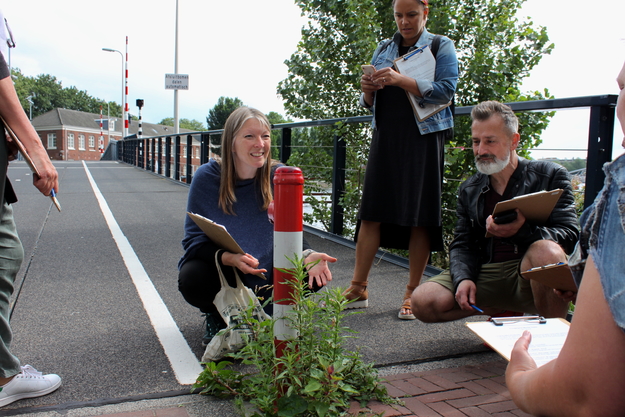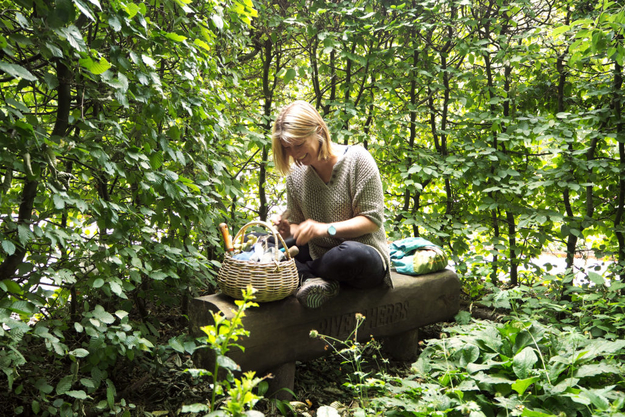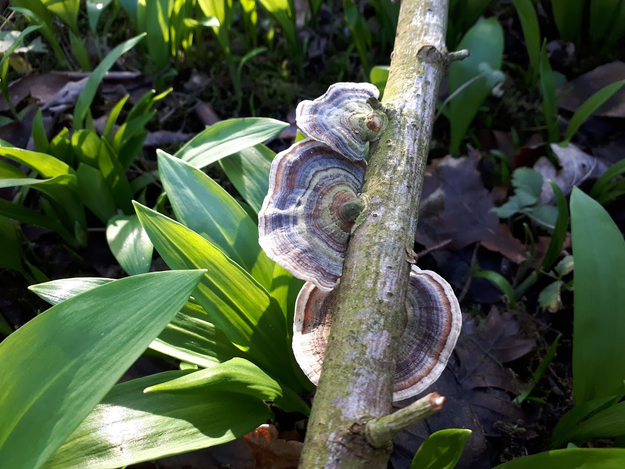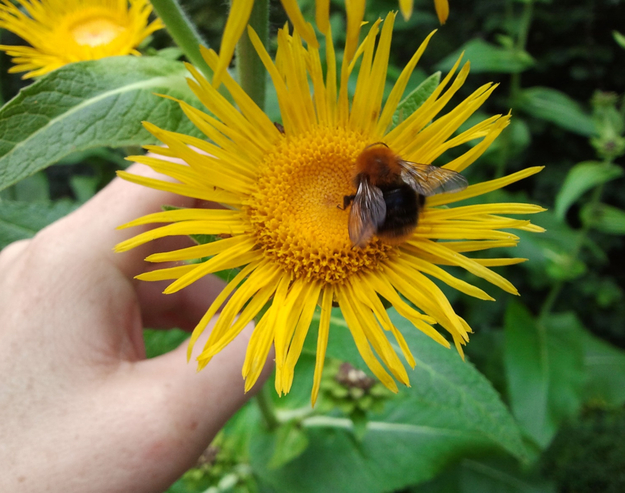Leone Contini - inclusive landscapes
Leone, joining live on screen from Italy, started off the evening with a presentation of his artistic practice surrounding inclusive gardens in Tuscany. He shared a number of images to illustrate his work, which involves interacting with farmers in art contexts.
“This is where I live, outside of Prato near Florence, a very rural area. There are woods nearby and and wild animals roam around at night - just to give you a bit of an idea.“
Leone continued: “I like to talk about farming in terms of landscape, inclusive landscape.“ He showed us another photograph: “This is a typical Tuscan landscape you may be familiar with, with a vineyard, olive trees, cottages -“
“- And this is the farm that belongs to my neighbour who is from China. He moved to Italy and he’s farmer, farming for his family and his community.“
“This is an olive tree and a karella, or kugua in Chinese, which is a bitter melon. It’s an unexpected fragment of the Tuscan landscape.“ This image, Leone explained, embodies his idea of an inclusive landscape.
Tuscan Cohabitations: The olive tree kugua - photo by Leone Contini

Another photo shows Leone’s neighbour planting a Chinese cabbage. “It’s a beautiful image, because he is turning this unfamiliar and foreign soil into a familiar space with this gesture.“, Leone explained. “The soil in Italy is very fertile and welcoming, unlike the politics - so many communities are able to grow their own vegetables and feel at home. You also have gardens of people from Sri Lanka, from Bangladesh, all these different regions.“
“Do you know how this started?“, artist Victor Evink inquired - “How did people from Asia get the idea to start small-scale farming in Italy?“
“The first time I saw a Chinese guy farming in Tuscany I was six years old, I think“, Leone remembered, “and this guy was the owner of a Chinese restaurant in Florence, so he was growing Chinese cabbage and spring onions in a very basic garden.“ During the recession in 2009, manufacturing activities slowed down so many people started farming more seriously, growing vegetables from seed outside the manufacturing areas where they lived and worked. “A lot of the time these small experimental gardens developed into family farms.“, Leone concluded.
“My work is also meant to show how this biodiversity is an opportunity for everyone.“, he continued. “This way we have a wider range of freshly grown vegetables in every season, not only Tuscan black cabbage but also the Chinese one - this increases my options and happiness!“
Foraging knowledge and seeds travel around with the people and communities they traditionally belong to, and Leone highlights these travels and the eventual homes they find through his artistic work.
To conclude his presentation, Leone showed us a final image: “I wanted to end with this one, because it shows what is more precious for me in farming: the sharing. In this moment we are sharing seeds, but it is an opportunity to also exchange stories and feelings.“
What makes a garden inclusive?
“You were talking about inclusive gardens“, A/artist co-curator Annelies Wina Doom said, “So I was wondering, when is a garden inclusive for you?“
Leone referred us back to the image of the bitter melon climbing the olive tree. “It is using the olive tree to get more sun, but it’s not harming the life of the tree. So in a way they help each other, and that’s an inclusive garden.“, he explained. “Also when a garden is perceived as a platform for social interactions, across different cultures, generations, backgrounds - urban gardens are often such inclusive spaces. I visited some of them in different countries, and migrants there, including Italian migrants, grow their varieties of plants, and learn gardening skills from each other. These are places that make me feel really happy.“
How can I visit?
“How can I visit these places? The gardens and installation that you are making?“, Victor wanted to know.
Leone explained that most of his work is ephemeral in nature, dependant on the seasons, the weather, and many other factors.
He also mentioned that the Chinese gardens he showed us are not open to the public, as they are a contested topic in local politics. “It’s good to protect these places, because they are under danger of eradication. Politicians like to use them to invoke fear - “oh what are they growing, invasive seeds…“ - This is completely ideological, it’s not true. But you have to be careful not to overexpose these gardens.“
“But I have recordings and videos, I document my activities and turn them into books, stories, videos, lecture performances… so I can share it with you that way.“
Martijn Baas - patchwork plants
Our next presenter, Martijn Baas, completed an internship at Mediamatic and later returned to host the workshop “Grafting Cacti“.
What is grafting?
Grafting is a basic principle in agriculture. “Apple trees are always grafted“, Martijn said, “Just like mango trees, avocado, walnut, almond…“ This is done to ensure the quality of the fruits these trees produce is always the same. “Naturally, trees would reproduce sexually like humans, and all their children are different, but we don’t want different children when it comes to apples, we just want the perfect apple - so we graft them.“, Martijn explained.
“In my practice people often start talking about ethics, asking Is this moral? But for me it’s clear that as humanity we depend on the grafting process when it comes to food production.“
Martijn’s favourite plant
“This is my favourite plant“, Martijn showed us. The top part comes from a desert plant and the lower part is a tropical cactus. “I’ve been able to grow a desert plant on just water for three years, which is really weird.“, he told us.
Martijn explained that he put the plant together with the image of a flower or tulip in mind, largely because of their contradicting qualities: “A flower is like reproductive organ that only lasts for a short while, and this thing is basically just a stem, so it can just live on. I also like its aggressive nature as opposed to a flower.“
“The more things you try, the weirder you can make it look“, Martijn said. “And my goal was to make it look like neither of the two species but like a new thing altogether. I like being a bit of a Frankenstein.“
“I think it has a lot of humour, your work.“, remarked photographer Marna Slappendel.

Why cacti?
Martijn explained that cacti are best suited for his practice because not only is it possible to graft all the different species of cacti, but they also come in a myriad of interesting shapes and sizes.
If the grafted cacti sculptures stay alive for a long time is a different question, he admitted - they might disintegrate, the two halves falling apart.
“How do you attach them?“, Marna asked. “I cut them with a razor blade, then attach them, and then let it heal.“, Martijn explained. “And they need to be actively growing.“, he added. “Sometimes that’s the hardest part, because they can get dormant.“ Usually, cacti only grow actively during the summer when temperatures are high.

“So what is your next phase?“, Marna wanted to know, and Martijn said that he would like to work on the project in an environment better fit to the needs of cacti. “In autumn and winter it’s really hard to keep them healthy.“, he explained. “So the next step would be to do this in a warmer climate, where I could graft more layers and experiment more.“
How did this project come to be?
“How did you get the idea to use cacti as sculptural material?“, Victor asked. Martijn explained that he first got interested in creating bonsai trees, which is considered a classical art form. “So I started out with miniature trees, but cacti are more experimental and that’s what drew me to it.“ Another factor was an encounter with a grafted cactus in a shop. “There’s this one really tacky grafted cactus that you can buy everywhere, it has a green stem with a yellow ball on top and it’s actually a desert plant combined with a tropical one. But people don’t realise this, it’s just there. So I thought if that is possible, you can make a lot of different stuff.“
Lynn Shore - plants are it!
Our third and final presenter of the evening was Lynn Shore, who regularly hosts the Foraging for Mental Health workshops at Mediamatic.
Lynn’s background
Lynn started her presentation by walking us through her career up to the present moment. She told us that she first worked in genome research at Cambridge but left after a year due to being concerned about the implications of the research and practices in this field. She became a biology teacher instead, and finally specialised as a learning support teacher, a profession she has been working in at the British School in Amsterdam over the past years.
What’s a learning support teacher?
“What’s a learning support teacher?“, someone wanted to know.
“I’m a special educational needs and disabilities specialist.“, Lynn said. “I’ve been doing that for quite a long time now, and my aim with it is to just enable everyone to learn to the best of their abilities. Because we’re in this awful set-up, having to go through exams and fit in sort of pigeon holes to get people through education - actually I’d rather always be out in the garden with these people who don't find the education system so accessible, talking with snails and plants. I’d always been really into plants, so from the start I was using plants to help the kids in the school.“
Horticultural therapy
Lynn is also a trained horticultural therapist. “We use gardening skills, anything linked to nature and gardening, to help people to get through obstacles“, she explained. “Because everybody has a combination of bits and bobs going on and also huge things, let’s not put it down at all, but we all need ways to find balance.“ In addition to this, Lynn also is a herbalist - “I’m obsessed with that too, with how plants can help us.“
After moving to Amsterdam 20 years ago, she started familiarising herself with the local plants. She was able to find a home for her practice and a place people can come and visit in Park Frankendael, at the back of the restaurant Huize Frankendael. The municipality allowed her to take over four old orchards around the premises. “We’ve transformed it over the years to what I see as a sanctuary.“, Lynn told us.
The stronger your connection to nature, the better
Lynn also showed us some research findings she collected on biophilia, the love and attraction to nature and all living things.
Her work with people centers around nurturing their connection with nature, since this connection also strongly influences their wellbeing. Spending time in nature has been proven to reduce stress and anxiety, and improves sleep, energy levels, and creativity, among many other things. At the same time, a better relationship to nature also results in increased care for it. “And the better our care for nature, the better our resilience as a human species, and the likelier we are to survive“, Lynn outlined the bigger picture.
“If you stare at a tree for 10 minutes in your office you feel better, physiologically you feel better. The same is true if you can just get your hands in the soil - you’ll feel innumerably better.“, Lynn said. But why is it so good for us? Recent research suggests that being outside and connecting with nature boosts our immune function. And with better immune function comes better cardiovascular health, a lower blood pressure, and so on and so on.
How do you relate to nature?
People can have a variety of different attitudes toward and relationships with nature. For example, they can feel aesthetic appreciation for its beauty, or a naturalistic relationship of gaining pleasure from immersing themselves in it. Other kinds of relationships are symbolic, expressed through art and literature, or scientific, being fascinated by the workings of nature. However, relationships can also veer into the negative, utalitarian ans looking at nature simply as a resource, to dominionistic, desiring to control it, and even negativistic, feeling fear or anger towards it.
“Some people have a desire to control nature and I think that happens a lot with gardens“, Lynn said. “I know when I was growing up there was a lot of weed killing going on and trying to control those plants, also the Japanese Knotweed - “
About the Mind Garden project she said: “I thought it would be interesting to attract people who express all these different relationships with nature. Even someone with a negativistic relationship.“
What works
Lynn also shared some trusted elements of her work that have proven beneficial over the years. “For me it’s green, really a lot of green, lush, tall, surrounding, and the opportunity for soil on the skin, I think that’s super super important.“ Other elements are phytoncides in the soil and terpenes in the air, which affect our bodies without us consciously noticing them. Also gazing opportunities - giving people the time and space to just look at plant or a landscape or the sky.
Example plants
Next, Lynn introduced us to a few of her favourite herbs. “Vitex agnes-castis - a fabulous shrub! It grows here, and it’s also called monk’s pepper, because monks apparently used to chew on it to repress their desires. We use it for all sorts of things, it’s very calming.“, she gave an example. “There’s the cypress, with beautiful oils coming out of it, the linden tree… a massive proportion of plants in Amsterdam are edible. I feed myself with Turkish hazelnuts through the winter and there are some fruit trees, lime, my dining room table is filled with them every year.“
Foraging - plants are it!
Lynn also teaches people foraging skills. “I do loads of foraging all the time in the city“, she said, “And I think it’s so empowering - so so empowering - that you can go and pick your own food!“ People are often daunted by the number of plants around which seem impossible to identify. “I tell them: learn the families. If you learn a family of plants, then you know the positives and the risks and what it is likely to do - and you’re set, it’s great, fabulous - plants are it!“
“I like everything I do to satisfy the three criteria: that it’s good for the plant, for wildlife, and for people as well.“

Lynn’s brain in a garden
Finally, Lynn showed us a picture of her community garden in Park Frankendael. “This is one of the orchards, that’s wild garlic, garlic mustard, geraniums, some goji berries in there, forsythia, gooseberries and there’s a fig tree that’s never gonna do very well but someone grew it from a seed and they love it - it’s a big mixture of what people who have helped to maintain it have loved, cherished and they wanted to give it a home.“
“Here you can see me stood in a willow hut thing, which to me sort exemplifies “my garden“ - it’s protective, green and nurturing, I’d say this is my brain in a garden.“
Willow hut - Photo credit: De Brug 
Writing about this?
“Have you written about your work?“, Victor asked. “Can I read anything?“ Lynn explained that she kept a blog for 12 years, and that there are written resources for the apprentices she teaches in herbology and horticultural therapy, but that she often times finds herself too busy actually doing the work to find time to write about it.
“I can imagine.“, Victor said. “And at the same time there must be people writing about this who never actually do it.“
Labeling plants, labelling people
Victor went on to outline a research project he used to be involved in, which dealt with the classification and labelling of plants in17th and 18th century Europe. Through colonial trade, knowledge systems clashed and intermingled, with folkloric knowledge of the Greek and Roman civilisations meeting indigenous knowledges from other parts of the world, as well as strict labelling practices of the incumbent colonial powers.
“I’m very into that!“, Lynn said. “People get attached names and we have labels with conditions for the poor plants but they’re just plants, they are not asking for it and they don’t need it… It’s about a connection, a one-ness with the plants, that’s the thing really.“
“Exactly, the interrelation with the plants, that’s what indigenous and also folkloric knowledge is about - the relation of specific effects, specific functions, roles, was a lot more important than the morphology. That only became dominant due to trade and the commodification of these things.“
“I find it interesting that you are talking about the plants not asking for the labels“, another guest added. “It’s a bit reflective of the diagnostic system and the DSM and everything - usually you’re not asking to be labeled, you just want to have freedom and have your needs met, to be cared for like everyone else. The labels are usually for others, to contain you in some way, and labels for plants are the same, to structure and contain and have control over them.“
“Or give control to them - “, someone else argued. “Depending on the label, it can also expand vocabularies and be empowering.“
The artist agreed: “Yes, we can reclaim it, like queerness which used to be a slur but has been reclaimed.“
“Actually the whole initial question for the Mind Garden project is to go beyond a simple label“, Willem reminded us. “To express the peculiarities of an individual’s mind in a garden, so that it’s much more accurately complex.“
Conclusion: what did we learn about Mind Gardens?
We wrapped up the evening with a lot more inspiration for the Mind Garden project. A mind garden can include comforting and familiar plants that represent your home, and other places that are dear to you, as in Leone’s inclusive gardens. It can be strange and experimental, like Martijn’s grafted cacti. And it can be informed by the plants’ medicinal and other properties, playing directly with effects nature has on our brains and bodies, as is the case in Lynn’s work.
Links & Resources
Leone's website: https://www.leonecontini.com/
Lynn Shore and Urban Herbology: https://urban-herbology.org/tag/lynn-shore/
River of Herbs (with Blog by Lynn): https://riverofherbsblog.wordpress.com/







